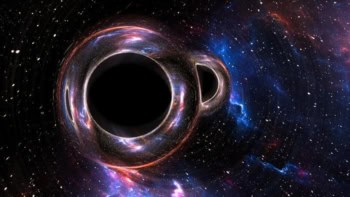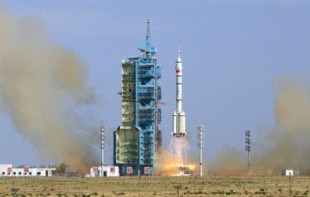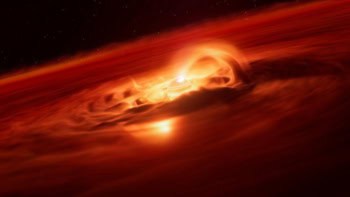The Universe: A Biography
John Gribbin
2007 Penguin
256pp £20.00 hb

The title of John Gribbin’s latest book – The Universe: A Biography – suggests we might be in for claims that the universe has a life of its own, but in fact this is a book packed with physics. The particle physics of the early universe, string theory, cosmological nucleosynthesis, the nature of dark matter and dark energy, the formation of galaxies and the solar system, the production of elements in stars and the nature of interstellar dust are all explained in considerable detail and with some style. Gribbin excels at getting difficult ideas such as quantum mechanics across and is a master of the homely analogy. I liked his emphasis that it was astronomical observations that first revealed to us the number of types of neutrinos and showed that neutrinos must have mass.
What makes this book unlike a biography is that very few people are mentioned. Perhaps so many are involved in cosmology these days that it can be overwhelming to name-check them all. As Gribbin says, “It is extremely rare for cutting-edge research nowadays to be carried out by a single country (let alone a single research group at a single university). The days of the lone genius – a Newton or an Einstein – are long gone.” But it still seems odd to talk about electroweak unification without mentioning Abdus Salam and Steven Weinberg, or the cosmic microwave background (CMB) without Arnold Penzias and Robert Wilson.
Indeed, given the significance of the CMB for current cosmological research, it is introduced rather cursorily in just a few sentences. Later we read that “increasingly sophisticated studies…by NASA’s WMAP satellite early in the twenty-first century and the European Space Agency’s Planck Explorer a little later showed that the universe is indistinguishably close to flatness, so its density must be indistinguishably close to the critical density. This left the puzzle of where the ‘missing’ mass (sometimes called dark matter, since it has never been seen) was”. This short extract manages to announce the results from the Planck mission before it has been launched, incorrectly claim that the CMB data prove the universe is spatially flat, and lump together dark matter and the cosmological constant as “missing mass”.
Gribbin castigates those who have been slow to accept the consensus model of cosmology including a cosmological constant, implying that it is a result of their ignorance of the history of their subject. My own impression is that the community has in fact been too quick to accept a picture that lacks a physical motivation. He also has a selective memory of his own research contribution: “I have a fondness for pulsars, since the first important piece of research I ever did, as a PhD student, was to show that pulsars could not be white dwarfs.” In fact, the abstract of his paper with John Faulkner (Nature 218 734) reads: “The rapidly pulsating radio sources may, after all, be vibrating white dwarfs.”
I found the later chapters of the book, on the formation of the solar system and the origin of life, the most interesting. There have certainly been striking new developments in these fields in the past decade. For example, the discovery of “hot Jupiters” – planets the size of Jupiter but much closer to their parent star than Jupiter is to the Sun – implies that Jupiter-mass planets may form in a completely different way to the terrestrial planets.
Gribbin’s marshalling of what is known about organic molecules in the giant molecular clouds where stars form and the composition of meteorites is highly suggestive of his claim that we are finding “the building blocks of the building blocks of life”. Star-forming clouds have significant abundances of hydrogen cyanide and acetylene, which can be used to synthesize amino acids; and traces of glycoaldehyde, which is involved in the synthesis of ribose. Meteorites contain amino acids, carboxylic acid and sugars, including glycerine and glucose. All this suggests that the cloud from which the solar system formed could have made quite complex organic molecules, and even if they did not survive the process of formation of the Earth, these molecules could have been transported to Earth by meteorites.
Work done by Lou Allemandola of NASA Ames on the synthesis of the large molecule hexamethylenetetramine (HMT or (CH2)6 N4) in the interstellar medium is particularly interesting. When warmed in water, HMT forms small hollow spheres, which were also found in the Murchison meteorite that fell in Australia in 1969. These structures suggest a mechanism for the development of the first life either in the Earth’s ocean or, more fancifully, in comet nuclei or even giant molecular clouds. But while Gribbin makes much of the fact that “in the late 1990s, astrobiologists discovered that amino acids found in meteorites are also left-handed”, like those of terrestrial life, there is a problem. Over 50 amino acids are found in the Murchison meteorite, but these do not include all 20 found on Earth; and while there is a moderate preponderance of left-handed molecules, it is not the overwhelming majority found in life.
In the final chapter of the book Gribbin moves on to the possible future of the universe, with a strong emphasis on the “ekpyrotic” model developed from M-theory by Neil Turok and Paul Steinhardt, a fairly wacky model in which the universe cycles between positive and negative cosmological constants as multidimensional “branes” collide and separate. Over all, despite some vagueness and inaccuracies, and the omission of names and references that would allow the reader to follow things up in more detail, I found The Universe: A Biography an enjoyable read.</p



